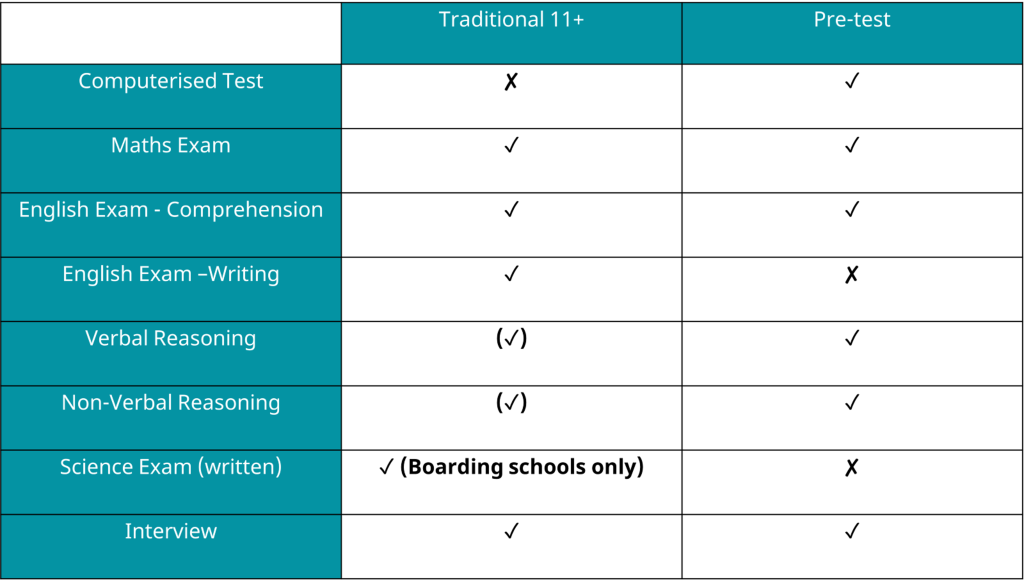Enjoy’s guide to secondary school entrance exams: 2022/23
16th September, 2022

The secret to successful secondary school entrance exams is prior preparation! There are different steps to take along the journey so being organised and well-informed means you can stay on top of the process and reduce any unnecessary stress for you and your child.
We’ve put together some useful FAQs below. If you have further questions, please get in touch with our team and we’d be delighted to have a conversation with you about identifying the right path for your child.
What is the 11+?
The 11+ is the term used to describe your child’s secondary school entrance exams taken in Year 6. Students take the 11+ in Year 6 for entry into Year 7.
Entrance exams differ widely across schools, and it’s always worth checking individual school websites for the exact details of what your child will be assessed on. Broadly, students will either sit an 11+ exam, the ISEB Common Pre-test or a CAT4 exam. Please see below for further details on the distinction between these exams.
Many schools invite students successful in their exams to an interview and/or a group activity day. This is an opportunity for the school to get to know your child and see how they might fit in at their school.

What is the 13+ Pre-test?
If your child is applying for entry in Year 9, it is likely that they will have to sit a Pre-test exam, either the ISEB Common Pre-test in Year 6, or the school’s own exam. This means that your child will sit their Pre-test exam for entry into Year 9 when they’re in Year 6 – the same year as the 11+. Even though Year 9 might feel far away, it is important to prepare well for the Pre-test because this is the most important exam to pass in order for your child to be offered a place to start in Year 9.
For entrance at 13+, some schools also require students to take the Common Entrance exam in the summer term of Year 8, which tests English, Maths and Science, in addition to giving students the opportunity to take papers in a wide range of subjects, including Modern Languages, Geography, History and Latin. Sometimes the Common Entrance exam will only be used for setting purposes.
Popular schools using the Common Entrance exam for 13+ entry include Eton College, Sevenoaks and Godolphin School.
What are the differences between each exam style?
Entrance exams come in many formats. It is worth understanding the difference between these formats, as it may impact your child’s preparation, areas of focus and even the schools you choose to apply to.
The ISEB Common Pre-test
The Common Pre-test is taken online at a computer, usually at your child’s current school. Questions are multiple choice, and test English, Maths, Verbal Reasoning and Non-Verbal Reasoning. The test has to be taken by 30 November in most cases and the results are shared with all the schools you have included on your ISEB application form. Popular schools which use the Pre-test for Year 7 and Year 9 entry include Harrow, Westminster, St. Paul’s Boys and Charterhouse.
The ‘traditional’ 11+
The ‘traditional’ 11+ exam tends to feature assessments in English, Maths, Verbal and Non-Verbal Reasoning skills. The English part of the exam tests written comprehension, including vocabulary, spelling, grammar, understanding and inference, as well as often including a writing task. If your child excels at creative, argumentative or persuasive writing, this style of exam may play to their strengths. Popular schools to use this format include Emanuel, Haberdashers’ Girls, North London Collegiate and Putney High.
Some schools use the 11+ format but include extra assessments or twists on existing areas. For example, St Paul’s Girls, Alleyn’s and City of London School for Girls use a Pre-test as a first assessment. Sevenoaks’ English exam tends to include fewer, high mark language analysis questions in comparison to the ‘traditional’ 11+.
New Consortium Style
You may have heard the phrase ‘Consortium’ on some schools’ websites. The 11+ Consortium is a group of girls’ schools using one standardised test to assess 11+ candidates, rather than individual exams at each school. Popular schools using the Consortium Style assessment include Channing School, Godolphin and Latymer and Francis Holland schools.
The assessment is a 100-minute online exam, with five distinct components testing Maths, Non-Verbal Reasoning, English Comprehension and Verbal Reasoning, Problem Solving and Analysis.
Multiple Choice Formats
Some schools use multiple-choice formats, either their own exams or those supplied by assessment centres such as CEM or GL. It is common for grammar school exams to be in a multiple-choice format, but this is not always the case. Popular schools using the multiple-choice 11+ format include Latymer Upper, City of London Boys’ School and Henrietta Barnett.
The CAT4
The Cognitive Abilities Test Fourth Edition (CAT4) is a series of tests developed to help schools understand academic potential. The exams test reasoning with words, reasoning with numbers, reasoning with shapes and designs and thinking with and mentally manipulating precise shapes.
Some schools use the CAT4 as part of their entrance assessments, while others use it for setting purposes for Year 7. Popular schools to use the CAT4 for Year 7 or Year 9 entry include Wycombe Abbey, Christ’s Hospital School and Bromsgrove School.

How do I choose which schools to apply to?
There are many factors to take into consideration when finding the perfect school for your child. While academics are important, you’ll also want to consider how the school will suit your child and their interests – do they have great sporting facilities or sports teams for children who love sports? If your child loves drama, the arts and music, do they have a great drama department and opportunities to get involved in plays and musical performances?
Each child thrives in a different environment, and you’ll also need to take the character of the school into consideration. Will your child do well in an academically competitive environment, or do they thrive with less competition? Is a small, tight-knit school better, or will they do well in a large school with all the opportunities this affords? What does the pastoral system and leadership team look like at the schools you’re applying to, and how supported will your child feel in this environment?
If you’re not sure where to start with choosing the right schools for your child, we are here to help. Our network of specialist schools advisors have decades of experience supporting families to navigate the UK schools landscape, and can help you narrow down your list and identify those schools where your child will thrive.
When should I start preparing my child for the Pre-test and 11+?
When it comes to the Pre-test and 11+, slow and steady wins the race. We would recommend starting to consider schools and begin light preparation in Year 4, so that you can start to build strong foundations for Year 5.
Enjoy Education offers academic assessments with written reports for students preparing for their entrance exams, providing families with an understanding of their child’s strengths and areas to focus on ahead of time. This allows you to support your child’s entrance exam goals and have a clear plan for success.
If you’d like to speak to our team about your entrance exam journey, we’d be delighted to have a conversation. Please get in touch via the form below.
What should I do to prepare my child for interview?
The interview is an opportunity for schools to get to know your child, their interests and see how they would fit into their school. To support your child at interview, we’d recommend encouraging them to read widely and keep learning. Get in touch for our interview questions and recommended reading lists. Plus, you can build on your child’s passions by taking them to museums, galleries, or by giving them the opportunity to try something brand new, from fashion design to coding or film!
Get in touch for our recommended interview tips, or to arrange a confidence-building practice interview with an ex-head of a top independent school.